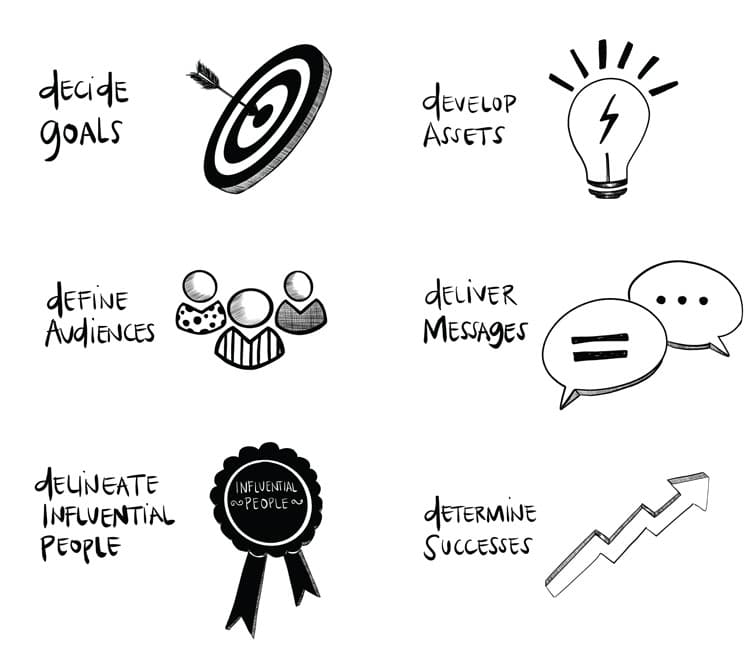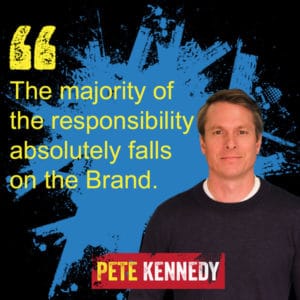
“Influencers just don’t convert.” If I’ve heard this once, I’ve heard it 100 times.
And each time I get a full explanation of how that particular brand manager or marketing executive came to that conclusion, my inquiry turns up the same result: It’s because YOU didn’t set them up to convert properly.
Heck, 90 percent of the time I hear that, it’s from brands that don’t even sell product online. Or they do, but don’t give the influencer a trackable link to even know if they convert. The brand simply hires an influencer to share the product with their audience (almost always as a play for brand awareness), then thinks sales are suddenly going to spike.
In that scenario, the only way you even have a chance of measuring conversion is if you’re doing absolutely nothing else in your marketing, including running your regular social media content. You have to literally go dormant for the days leading up to the influencer engagement, and stay dormant for 30-60 days after.
If for the 1-30 days after the influencer’s post you see anything other than your control level of units sold when we do jack shit, you can *probably* attribute the lift to the influencer.
But *probably* is the active word there. Since you didn’t give them a shareable link that you can track, it might be that someone’s mom discovered their daughter was using your product and made up a story about it at Sunday brunch. The ensuing frenzy on dance team mom Facebook groups linking your product to frizzy hair or stocking runs made everyone run out and buy your thing to test it for themselves.
One of my long-standing mantras around digital marketing is that you have to plan to measure. If you as a brand do so, you avoid the pitfalls of lobbing water balloons over the influencer fence hoping they hit a customer or two. You actually build content partnerships designed to convert, that empower the influencer to convert, and that make it easy for you to see conversions … or adjust if you don’t.
The bottom line is an influencer’s ability to create conversions for your brand is not their responsibility. It’s yours.
And thus, if an influencer doesn’t convert for you, the blame is all on you.
Let me explain …
The Six Steps to Building Influence Marketing Campaigns
In Winfluence (the book), I mapped out the Six Steps to Building Influence Marketing Campaigns. They are:

- Decide goals
- Define audiences
- Delineate influential people
- Develop assets
- Deliver messages
- Determine successes
Each one of them has an important correlation to building an influencer or creator partnership that converts.
First, you have to decide that conversions are your goal. Brand awareness goals lead to more people being aware of your product. That doesn’t necessarily mean they’ll buy it. Mixing two types of goals in one effort is only going to water down and confuse the audience. It’s best if you pick one or the other.
Defining the audience isn’t just your target demographic. It’s people who are ready to buy your product. If you sell something seasonal, like patio furniture. You can’t target people aged 30-55 with a household income of $100,000 in the U.S. You have to target people in certain geographies with sensitivity to the time of year. Patio furniture probably sells earlier in the year in Florida and Texas than it does in Maine and Minnesota.
So make sure you are basing all the other steps on the right audience.
That informs which influential people you choose. They not only have to speak to the audience in question, but also need to be the types of influencers that can drive conversions. A home decor creator that inspires their audience is very different than one who reviews products. The latter is typically far more apt to drive sales than the former.
The assets you develop with conversions as the goal are also different. Yes, you want to equip your creators with great product shots, but with conversions, you also want to give them instructions or talking points on the unique selling proposition, useful features or how-to content on using the product itself.
You also want to make sure they have the appropriate trackable link to use and are given guidances on calls-to-action to prompt the conversions. Don’t leave it up to them to decide … tell them, “We need you to prompt your audience to purchase on this site or this channel using this code on these dates.” Otherwise, the creator is liable to show off the product and then move on to the next thing.
And from those assets come the messages they deliver. The unique, trackable URL. The discount code. The specific call to action. Those help solidify the chances your creator is set up to succeed in converting their audiences to buy your product.
This Isn’t Just My Opinion
Hopefully, this line of thinking sounds logical and rational to you. (It probably should.) But don’t take it from just me. Others agree that the onus is on the brand to set influencers up for success.
Crystal Duncan is the senior vice-president and head of partnership marketing at Tinuiti, which evolved from an SEO firm to focus on performance marketing. So it is all about conversions.
“Who the influencer is, who their audience is made up of and the content they are creating are probably the more important pieces to a successful influence program,” Duncan explained. “In order to see the magic of an audience taking an action (purchasing, favorability, usage, etc.) you have to make sure you have those three pieces in mind.”
In case you didn’t catch the insinuation, that means you have to choose creators that meet those criteria. It’s not their responsibility to suddenly fit your mold. Being disappointed with the type of influencer, audience or content that resulted in poor conversions means you didn’t choose the right ones on the front-end.
 Peter Kennedy, the founder and president of Tagger, the popular influencer marketing software solution, goes a step further.
Peter Kennedy, the founder and president of Tagger, the popular influencer marketing software solution, goes a step further.
“The majority of the responsibility absolutely falls on the Brand,” he said. “Marketers now have access to a wealth of data points for Influencers. Brands can have a clear picture of an Influecer's community's psychographic. They can understand their interests, what types of content activates them, establish benchmarks to measure success. If a brand is running an influencer campaign without that type of due diligence then they should expect less than stellar performance and murky success metrics."
That’s a nice way of saying, “Do your homework.” Or perhaps a step further, “This is on YOU!”
Disclosure: Tagger is the presenting sponsor of Winfluence – The Influence Marketing Podcast.
How Brands Can Drive Influencer Conversions
Before your brand gives up on driving conversions with influencers, let me encourage you to re-think and perhaps retry a conversion effort using your creators. Start over and think through these questions:
- Which creators talk to consumers most ready or willing to buy?
- Which creators believe in my product enough to passionately recommend their audience buy it?
- How can I make it easy for their audience to purchase?
- How can I track those purchases with appropriate attribution to that creator?
If I’m selling patio furniture and I really want to drive conversions, I’m going do a few things to ensure I can be successful:
- Choose home decor and family influencers who frequently recommend and review that type of product.
I’ll look for those who offer shopping links and affiliate type content to their audience, but still have a good balance of engagement and non-sales content. I might even intentionally find ones that do Amazon Live or actively promote products on their YouTube channels or live streams. - Plan your campaign for the where and when people are considering or buying
I’ll choose more Southern-based creators in March and April, then migrate my partnerships north as May and June roll around. I may engage those with a nice national footprint for the entirety of the calendar, but I want to reach people who might be shopping for my product when they are, not in November when no one wants to be on the patio. (But I might have a few Southwestern U.S. creators doing things then since winter is premium outdoor time in some places.) - Make it super-easy for people to buy the product the creators talk about
Instead of sending the influencer’s audience to my website or a category page, I’ll build a landing page with just the 2-3 items the creator talks about. Lobbing everything I sell at them is only going to add friction to the process and cause them to drop off. I want the creator to show off his or her new Autumn Luxury chair, sofa and table patio set. Then when they land on my website, they’ll see the new Autumn Luxury chair, sofa and table patio set. They can add to cart and buy right there. - Make it simple to track conversions
Since I’m creating my own landing page, I can make it jasonspatiofurniture.com/isaacinfluencer (or similar) so it’s easy to say, remember and recall if someone sees the content away from the time or device to click through upon. Even better, I’ll route that URL through my custom URL shortener and make it patio.online/isaac. If I can’t do all that, I’ll at least have my landing page URL run through a UTM parameter builder with the medium set to “influencers” and the source set to “issacinfluencer” so that short URL will register that creator’s traffic when the customer hits the website. Isolating a conversion report using the medium and/or source is then a simple task.
Don’t Give Up on Influencer Conversions
The final tip I’ll give you on building influencer marketing campaigns that convert is to not give up. The digital marketing space in general, and the influencer marketing segment of it as well, are still fraught with inconsistencies, anomalies, and downright weirdness. You should approach everything … and certainly everything new … with a test-and-iterate attitude.
Plan a campaign, choose influencers you think might convert, build it out wisely and see what happens. Then do a thorough analysis of what worked and what didn’t. It might be that you had everything set right but chose an influencer who wasn’t quite as good at persuading their audience to buy as needed. So, find a different one, or set of creators, and try again.
Make sure you’re checking all the boxes on your analysis we’ve discussed here. Do the creators talk about your product with a genuine passion? Do they make it clear what the benefit is in buying this? Do they point their audience in the easy direction you’ve built out? Does your website landing page function properly? Have you tested it for conversions from other channels to know there aren’t hiccups on the sales page?
Being thoughtful about building an influencer conversion campaign, but also about assessing it, will push you closer to having the kind of success you’re looking for.
Have an example of a conversion problem, or success story, you’d like to share? I’d love to know about it. Drop me a line at [email protected] and tell me more. I might use your example on a future newsletter or even interview on the podcast!
Click here to return to this month's issue of the Winfluence email newsletter.
Photo by rupixen.com on Unsplash

